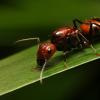I just recently decided to jump into ant keeping and this forum and need some help. I caught this queen on 9/26 outside my home in Elko, Nevada. She was sitting inside a knot on a weeping willow tree. She is significantly larger than other ants around her, roughly 15mm. She has a dark red/brown coloration with two-three bands of a honey brown on her gaster. Her gaster is very large while her thorax is slightly bulbous, but proportional to the size of her head. Her legs are also very long. Here are some potato pics of her. Hopefully I remember to bring my camera home from work today so i can get some better pics. TIA! ![]()
Edited by CallMeCraven, September 28 2016 - 2:20 PM.


























